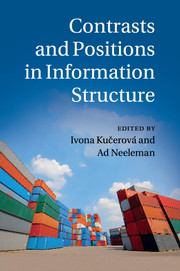Book contents
- Frontmatter
- Contents
- List of Contributors
- 1 Introduction
- Part I The architecture of grammar and the primitives of information structure
- 2 Predicate integration: phrase structure or argument structure?
- 3 Wh-intonation and information structure in South Kyeongsang Korean and Tokyo Japanese
- 4 Grammatical marking of givenness
- 5 Interface configurations: identificational focus and the flexibility of syntax
- 6 Focus and givenness: a unified approach
- 7 The locality of focusing and the coherence of anaphors
- Part II Exploring the interfaces: case studies
- Bibliography
- Index
7 - The locality of focusing and the coherence of anaphors
from Part I - The architecture of grammar and the primitives of information structure
Published online by Cambridge University Press: 05 August 2012
- Frontmatter
- Contents
- List of Contributors
- 1 Introduction
- Part I The architecture of grammar and the primitives of information structure
- 2 Predicate integration: phrase structure or argument structure?
- 3 Wh-intonation and information structure in South Kyeongsang Korean and Tokyo Japanese
- 4 Grammatical marking of givenness
- 5 Interface configurations: identificational focus and the flexibility of syntax
- 6 Focus and givenness: a unified approach
- 7 The locality of focusing and the coherence of anaphors
- Part II Exploring the interfaces: case studies
- Bibliography
- Index
Summary
Focus projection
Given that accent placement is mapped to information structure by regular rules, where information structure is a parsing of a sentence into ‘focused’ and ‘unfocused’ parts, the architectural question is whether the interpretation of accent placement is direct, or mediated by other systems. And given a representation of accent like that proposed in Liberman (1975), in which every pair of sisters is labelled as either ‘[weak strong]’ or ‘[strong weak]’, that question then becomes: can focus interpretation be reduced to interpreting [w s] and [s w] sister pairs, with nothing further involved? Otherwise put, is the locus of accent contrast, namely sisters, also the locus of the interpretation of that contrast? Williams (1997) suggested that it was, and presented the ‘Disanaphora Law’ and the ‘DOAP Law’ as an implementation of that view. In this chapter I will defend the theory further and widen its scope.
In a now standard line of theories of focus interpretation, such as that in Rooth (1992), the connection of accent to its interpretation occurs in two stages. First, syntactic constituents are identified as focuses on the basis of the location of accent prominences by rules of ‘focus projection’. These Focus-marked constituents are then subject to interpretation – in Rooth's theory according to principles stated in terms of the ‘alternative semantics’ of their ‘focus values’, principles determining such things as answerhood to questions, contrast, the interpretation of focus-sensitive adverbs, etc.:
(1) Classic theories: accent placement —–> focus —–> answerhood, contrast,…
- Type
- Chapter
- Information
- Contrasts and Positions in Information Structure , pp. 148 - 174Publisher: Cambridge University PressPrint publication year: 2012
- 1
- Cited by



